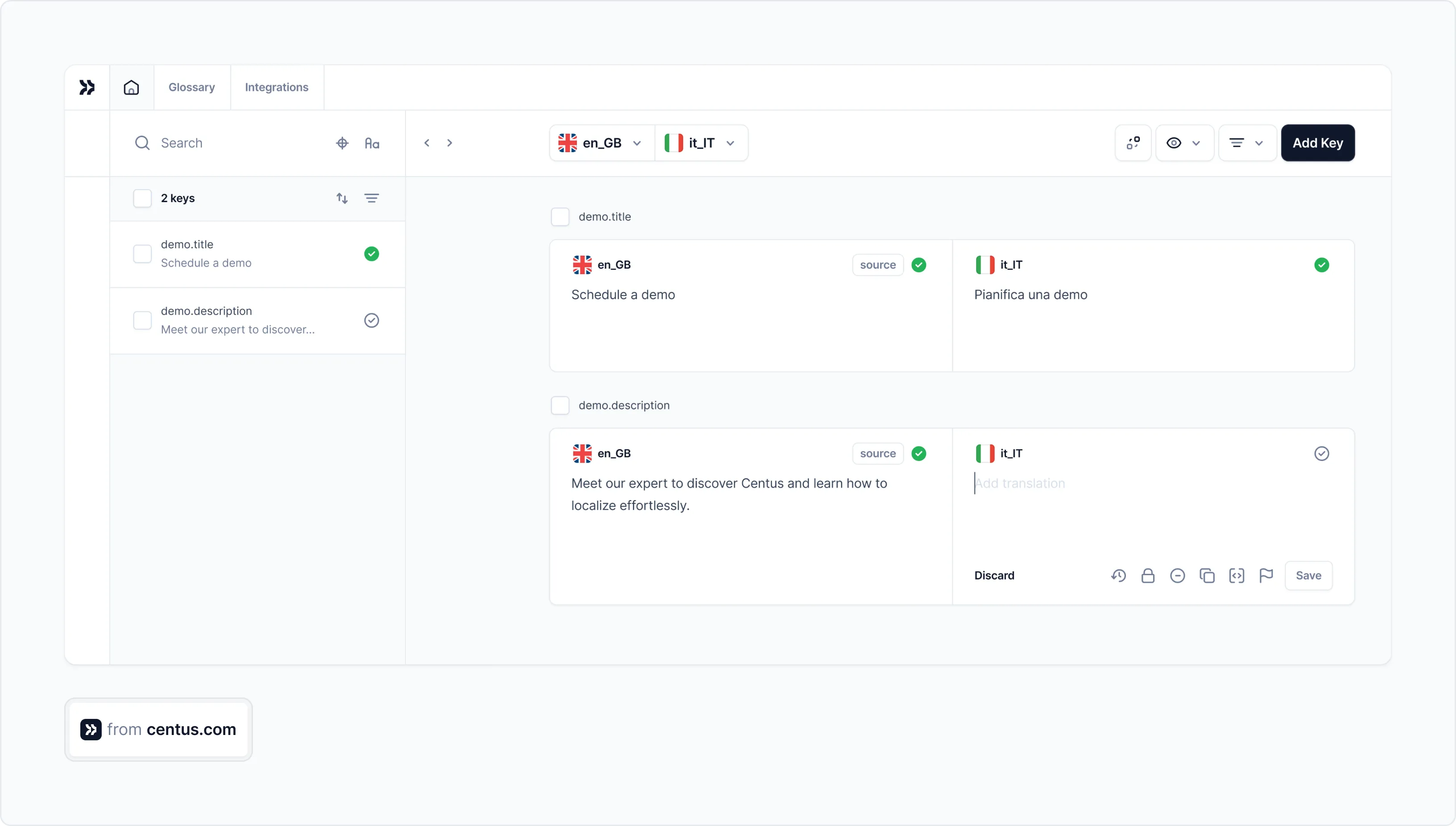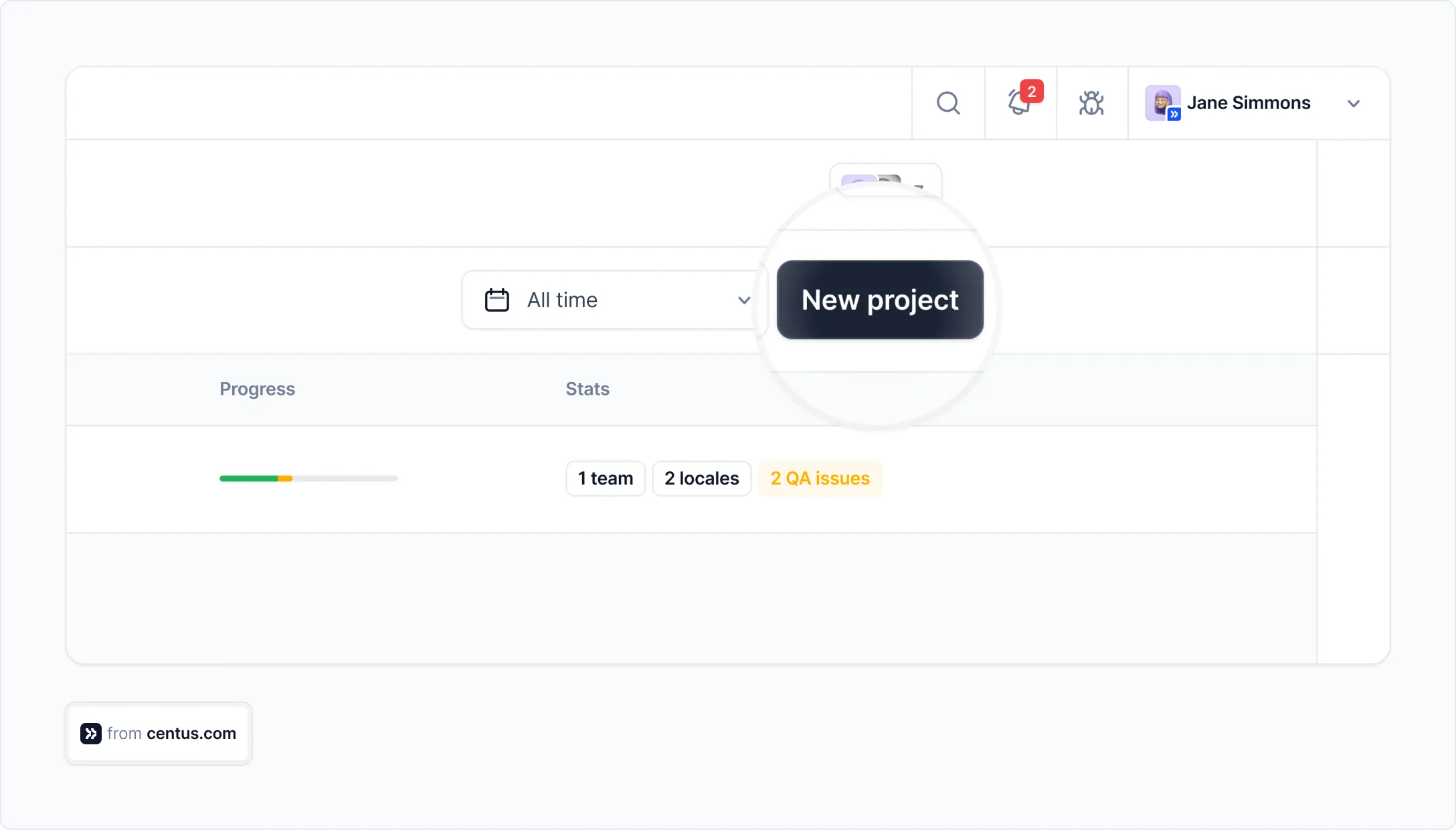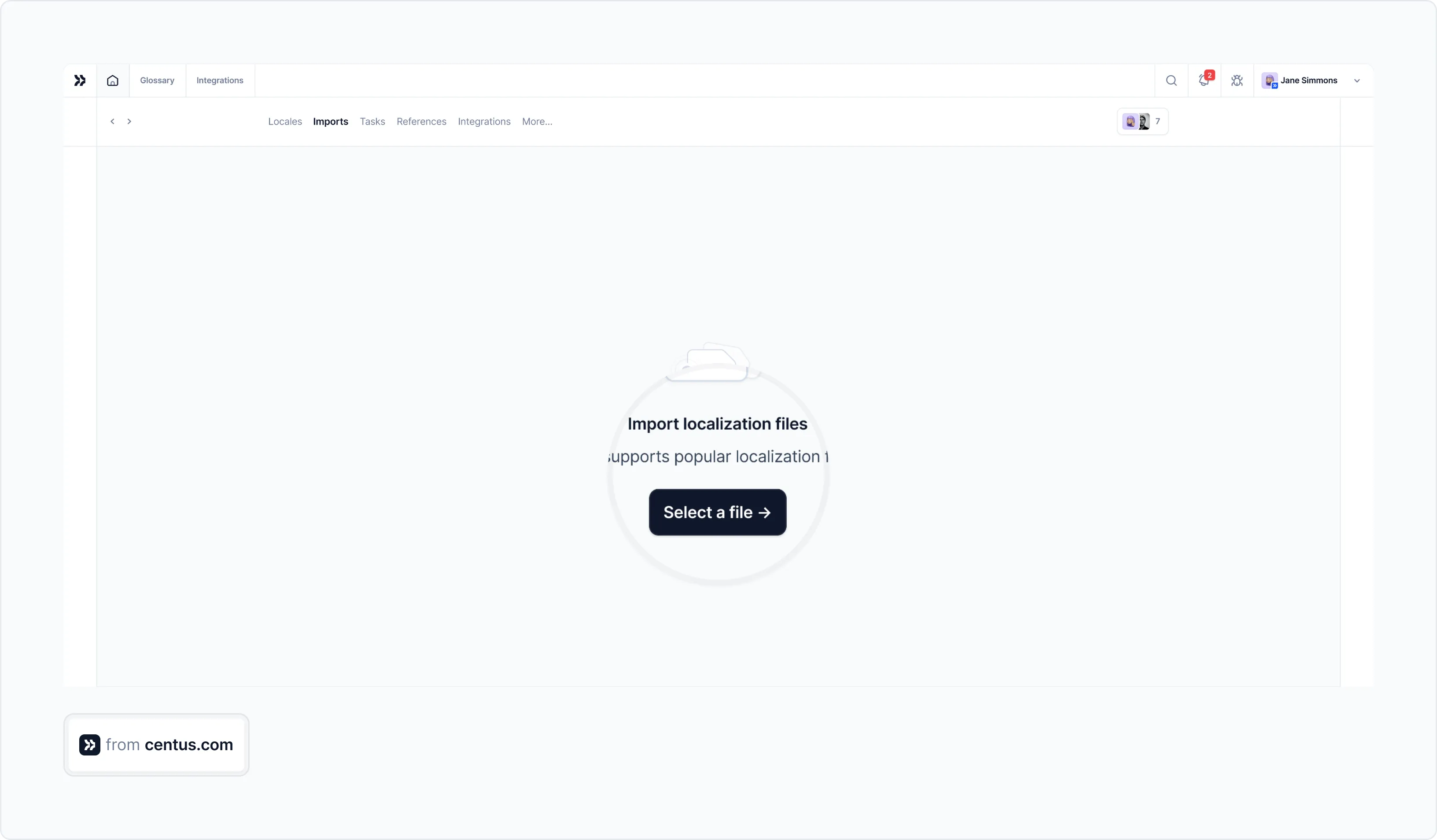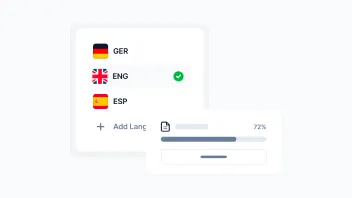Website Translation Costs: How to Calculate and Manage Them
The internet makes international reach possible—57% of online shoppers now buy from websites outside their home country. If your site is available in just one language, you're missing out on a major share of global customers.
Before expanding into new markets, it’s important to understand what website translation really costs—and what factors drive those costs up or down. This guide will walk you through the pricing models, cost influencers, and smart ways to budget for website localization.
Pro tip: Cut costs and simplify your workflow with a professional localization platform like Centus.
How much does it cost to translate a website?
Website translation is typically priced in one of three ways:
- Per word — $0.08 to $0.30
- Per page — $25 to $50
- Per hour — $15 to $75
Example: 10,000 words
At $0.08 per word, translating 10,000 words costs $800.
With hourly pricing, it depends on how long the work takes. At an average speed of 300 words per hour, translating 10,000 words would take about 33 hours. At $15 to $75 per hour, the total cost would range from $500 to $2,500.
Tip: Tools like Centus can lower costs. Start with automatic translation, then assign content for manual review. This cuts down on time and budget without sacrificing quality.

Factors Influencing Your Website Translation Price
The cost of translating a website isn’t fixed. It depends on several variables—such as the volume of content, the type of material, and the languages you're working with. Each of these contributes to how much time and expertise the job requires, which directly affects the final price.
Knowing what drives translation costs can help you plan and budget more effectively. Here's a closer look.
Content Size and Complexity
Translating a 10-page site with 5,000 words will cost less than working on a 50-page site with 20,000 words. That’s obvious. What’s less obvious is how content complexity affects pricing.
Take two websites with the same word count. One contains simple blog articles. The other is filled with legal disclaimers or technical product specs. The second one will likely cost more—because it needs a translator who knows the subject matter inside out.
Here’s a general breakdown:
- Basic website content: $0.05 – $0.10 per word
Includes general pages, blog posts, and standard product descriptions. - Marketing content: $0.10 – $0.20 per word
Applies to sales copy, branded messaging, or anything requiring precise tone and specialized vocabulary. - Legal or technical content: $0.15 – $0.35 per word
Covers legal pages, healthcare information, and technical documentation—work that demands accuracy and expertise.
If your site includes images with embedded text, videos that need subtitles, or interactive UI elements, the cost will rise. These assets often require subtitling, voice-over, or graphic editing services—typically priced per hour or per asset, not per word.
Keep in mind that rates may also vary depending on the language pair and the translation agency or freelancer you hire. Still, this breakdown offers a practical way to assess how your website’s content type influences the total cost.
Language Pairs
The content on your site is a major cost driver, but the language pair you’re working with can have just as much impact on your translation quote. Some language combinations are easier to source and translate than others, which affects both availability and price.
- Common languages. Translating between widely used languages—such as English and Spanish—is typically less expensive. These languages have larger translator networks and more tools available, which keeps costs down.
- Less common languages. Languages like Hungarian or Icelandic require niche skills and come with fewer translator options. That scarcity leads to higher rates, especially for specialized content.
- High-demand languages. Pairs like English-Chinese or English-Arabic often attract higher fees. Even though there’s a large pool of translators, demand is high, which can drive up pricing.
Languages that rely heavily on idioms, cultural nuance, or region-specific terminology require more than just fluency—they need cultural expertise. This adds time and cost to the process.
Even the same language can vary by region. Translating into Latin American Spanish may differ in price from European Spanish, due to regional differences in vocabulary, tone, and expectations.
Here’s a snapshot of average translation costs for popular language pairs, based on ProZ data:
| Language Pair | Per Word | Per Hour |
|---|---|---|
| English – Spanish | $0.10 | $33.40 |
| English – French | $0.11 | $35.26 |
| English – German | $0.11 | $35.13 |
| English – Icelandic | $0.15 | $40.03 |
| English – Chinese | $0.10 | $36.38 |
Translation Quality
The method you choose—human, machine, or hybrid—directly affects both the accuracy and cost of your website translation. It’s a decision worth making carefully.
Professional Human Translation
This approach relies on skilled linguists handling your content. It offers the highest accuracy, especially for material that’s complex, specialized, or requires a specific tone.
Typical rates range from $0.08 to $0.30 per word, depending on factors like language pair, subject matter, and translator experience.
Machine Translation
Tools like Google Translate and DeepL use AI to generate quick translations. They’re fast and low-cost but tend to struggle with nuance, tone, and specialized language.
Basic machine translation is often free or priced between $0.01 and $0.05 per word. Premium plans can cost a few hundred dollars per year. However, you should factor in time or cost for post-editing if accuracy matters.
It’s also worth noting the trade-offs between platforms:
DeepL typically outperforms Google Translate in overall linguistic quality, especially for technical content. Google, however, handles ambiguous or marketing-oriented language better—making each tool more suitable for different types of content.

Hybrid Translation
Hybrid translation combines machine output with human editing. The process typically starts with machine translation, followed by review and correction by a human linguist. It can also refer to workflows where translators use CAT tools to assist with consistency and speed.
This method offers a balance between cost and quality. It’s more affordable than full human translation but produces better results than machine translation alone.
Pricing depends on how much human input is required. Rates are generally lower than standard human translation, but not as low as raw machine output. It’s a flexible middle ground, ideal for projects that need quality without exceeding budget.
Note: All pricing ranges mentioned are averages. Actual costs will vary depending on your project’s size, complexity, and language pair.
Delivery Timeframe
Turnaround time is another factor that can affect translation cost. Standard delivery follows predictable timelines and rates. But when you need work done fast, the pricing changes.
1. Standard Delivery
This allows for a complete translation cycle: translation, editing, and proofreading. The typical timeline is 7–15 business days, depending on the content size and complexity.
Pricing remains within the normal cost ranges based on the quality level you’ve selected—whether human, machine, or hybrid.
2. Rush Translation
When speed is critical, expect to pay more. Urgent translations require extra resources or extended hours, and most providers charge a rush fee. The markup usually ranges from 10% to 50% above the standard rate.
The exact premium depends on how quickly the work is needed, how complex the content is, and who’s doing the work.
Additional Expenses
Beyond the core translation itself, several services can increase the total cost of translating a website. These often require specialized knowledge and extra work, which adds to the overall budget. Key contributors include website localization, SEO, and decisions around your site’s multilingual structure.
Website Localization
Localization goes beyond converting words. It means tailoring the content to fit the cultural expectations of your target audience. This can involve changes to:
- Language and tone
- Images and color usage
- Units of measurement
- Currency and pricing
- Date and time formats
The average cost for localization is around $0.40 per word, due to the added complexity. It may also involve design or development changes depending on how much visual or structural adaptation is needed.
SEO
To maintain or grow search visibility after translation, multilingual SEO is essential. This includes:
- Researching and adapting keywords for each language
- Translating meta tags, page titles, and descriptions
- Ensuring technical SEO is handled properly for each language version
These tasks require both SEO expertise and fluency in the target language, which can raise costs.
Website Structure for Multilingual Content
How you organize your translated content impacts both cost and workflow. There are two main approaches:
- Separate domains: For example, example.fr for French or example.de for German. This method usually requires more investment in development, separate SEO strategies, and maintenance for each site.
- Subdirectories or subdomains: Like example.com/fr/ or fr.example.com. This is typically more affordable and easier to manage centrally.
The structure you choose should match your business goals, resources, and long-term plans for scaling content in multiple languages.
Translation Services
If you expect frequent translation needs, building an in-house team might make sense. But this comes with hiring costs, onboarding time, and the challenge of scaling quickly.
Most businesses instead turn to external providers. Who you hire—and how—can have a big impact on your final translation cost. Here's an overview of provider types and what to expect.
Types of Translation Providers
1. Freelance Professional Translators
Freelancers work independently and usually specialize in specific language pairs and subject areas. They're a solid choice for small to medium-sized projects and often provide competitive pricing. However, for larger or highly specialized tasks, their capacity may be limited.
Typical rates range from $0.05 to $0.25 per word, depending on the translator’s experience and the complexity of the content.
2. Professional Translation Agencies
Agencies handle the full workflow: translation, localization, project management, and quality control. They’re better suited for larger, multi-language projects or when multiple translators are needed for fast turnaround.
Rates are generally higher than freelance rates, typically $0.10 to $0.30 per word. Some agencies also offer flat or project-based pricing, which can be more efficient for larger volumes.
3. Niche Translation Providers
These companies or freelancers focus on specific industries—legal, technical, medical, or scientific content. Their value lies in domain expertise and accuracy in terminology.
Because of the specialization, pricing is highly variable and usually higher than standard translation rates. For industry-specific content, however, this expertise is often non-negotiable.
How to Save on Website Translation
Translation can be expensive—but with the right workflow, you can reduce costs by as much as 90%.
The key is automation combined with human oversight. Instead of translating everything manually, use a localization management platform to automate initial translation, then involve your team for review and refinement.
Here’s how it works with Centus:
- Sign up to Centus and create a new project.

- Go to the Imports section and upload your files. Soon, Centus will support plugins for major CMS platforms—saving even more developer time. Stay tuned!

- Use built-in machine translation (MT) engines—Google Translate, DeepL, or Microsoft Translate—to pre-translate your content.

- Once pre-translated, assign content to your translators and editors. Let them refine and finalize the work together.

By following these steps, you can translate your website quickly and cost-effectively. Centus can also help localize ebooks, white papers, product manuals, and other digital content.
Parting Thoughts
Website translation costs can add up quickly. To manage your budget effectively, start by translating the content that matters most—pages that drive traffic, conversions, or customer engagement. Planning ahead also helps avoid extra fees tied to urgent deadlines.
Professional localization platforms can make a big difference. With tools like Centus, you can reduce costs by:
- Reusing existing translations
- Automating repetitive tasks
- Integrating machine translation
- Minimizing developer involvement
Focus on what matters, streamline your workflow, and keep your translation budget under control.
Happy translating!
Get the week's best content!
By subscribing, you are agreeing to have your personal information managed in accordance with the terms of Centus Privacy Policy ->
Keep learning
11 min. read
How to Choose and Use Translation Proxies
7 min. read
Human Translation vs Machine Translation: Which One Comes Out on Top

9 min. read
Business Translation Explained with Examples

9 min. read
7 Best Machine Translation Software Tools
7 min. read
Localization Specialist Role and How to Become One
11 min. read